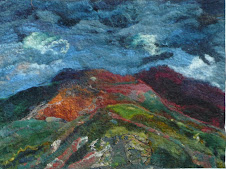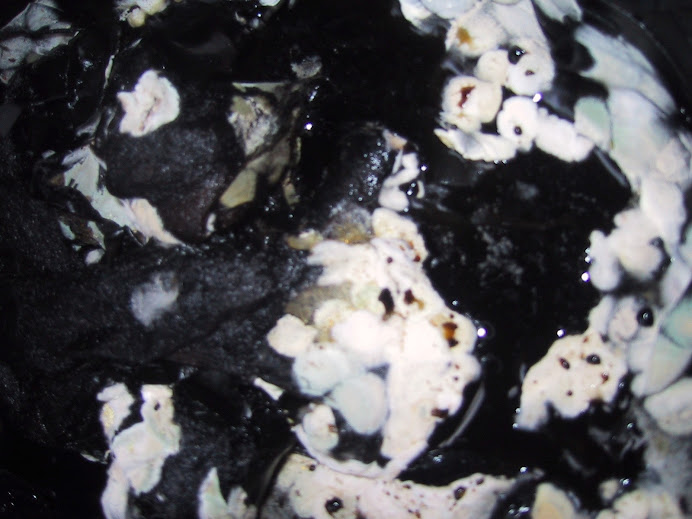 Posted by Helen
Posted by Helen I am often asked if second year woad gives blue and although I have done it in the past I thought it would be nice to have evidence!
A few days ago I cut about four second year plants of Isatis Tinctoria down to stop them flowering as I don't want them to cross pollinate with Chinese woad Isatis Indigotica which is in full flower.
As always I followed Jill Goodwin recipe from the Dyers Manual( Published by Batsford) so I ripped the leaves up and poured boiling water over them sufficient to cover the leaves , left them for about half and hour and then squeezed the leaves out and removed them leaving a brown liquid darker than the normal sherry colour I have got from first year leaves. I added about a 100ml of washing soda solution, {sodium carbonate) made by mixing 4 tablespoons of washing soda to 1 litre of water, which turned the liquid a sort of browny/green colour, beat thoroughly to oxygenate the water and precipitate the indigotin. Normally the froth turns blue but it did not show much sign of the blue froth this time suggesting that indogitin levels might be low. I added 1 teaspoon of thiourea dioxide and left for a further 20 minutes. The little vat was difficult to read as it was bright green and when I dyed fibres they went green, this was a yellow colour in the dye bath which washed off easily revealing the blue underneath. I added in the fibres shown and got as you can see pale blue on silk, on a textured yarn and quite a reasonable blue on the teeswater. I put the squeezed out leaves into a slow cooker and left overnight on the keep warm facility before adding teeswater curls and getting the resulting golden tan with a pinkish tinge.
So there you are you can get blue from second year woad leaves before they flower but the amount of blue you can get may be low.
Welcome to the new followers Manya , Danielle and Joybilee farm



























exiting!
ReplyDeleteThanks for posting this. I've been having such a busy spring I haven't had time to try this with my spring woad. I did boil some up, just to get that peachy-color. I also dried some leaves, just to see if, later, they'll give any color. Woad is such a vigorous plant!
ReplyDeleteThank you so much for giving us this very useful description of your process. One day I will be brave enough to try dying fibers!
ReplyDeleteLooks like I'm going to have more of the Japanese indigo plants this year (29 seedlings!) than woad, germination is slow now the weather had turned colder. I think I have about 5 woad plants at the moment.
ReplyDeleteWell it is just as easy to extract colour from Japanese Indigo,which in any case is higher in indogitin too I think-
ReplyDeleteand if you have 29 plants you will have quite a lot of dye!
hello and thanks for the welcome!
ReplyDeletea gardening question: do you think it is possible that here in Greece woad goes through its whole cycle in one season? in plants like this leaves usually come out in february, and the flowers shoot up about 40 days later. seeds have lready formed on the plants around here, none are woad, but I have my eye on a plant with the right flowers, greyish clasping leaves etc. waiting for the seeds....
Hi Manya I am sorry that I have been a bit slow replying but needed to check my favourite Dyeing book. Dominique CArdons Natral Dyes. This book,published in English a couple of years ago is very expensive but worth its weight in gold as it is full of information about dye plants. According to Dominque Cardon woad probably originated in South east Russia but is now widespread throughout Europe, Mediterranean and Turkey and Indochinea and has been spread to North America too. It seems to thrive in Mediterranean climates so you could well have woad in your locality. She say that Isatis Tictoria always flowers in its second year unlike Isatis Ingotica which sometimes flowers in the first year. However she admits that not enough is known about variants and when I asked Enys who grows my dye plants she says that it could well flower in its first year.
ReplyDeleteI need to to hunt a bit more in my dye books but there is a method of getting a leaf imprint in blue onto fabric from a plant bearing the indigotin precursor (Indigotin being the chemical name of the blue dye that gives us blue.
If you would like precise botanical description of Isatis Tinctoria let me know and I will copy it from Dominque Cardon's book.
wow, Helen, thank you for your answer
ReplyDeleteI have found descriptions and lots of pictures on the internet, I am plowing through my dyebooks (just arrived!) I have r. buchanan dyers and weavers garden and J. Liles, and J. Deans natural dyeing and also "wildflowers of the mediterranean" which is quite practical and helpful.
at the roadsides and in uncultivated fields there is a plant which looks very much like woad from afar, but the leaves are different- deeply lobed and the seeds are very different.
the plant I have found looks very much like the one in this picture
http://www.presentltd.com/rugs/arfp-natural_dyes_indigosources.htm
an I am waiting for the seeds to form to be sure- and to get some!
I'm also planning to visit plant nurseries to ask about the other indigo bearing plants
the reason I asked is becuse my favourite plantsperson, who has an intimate knowledge of all plants in this area shook his head in disbelief when I said that the flowers come out in the second year. I haven't noticed any of the "rosette" type "weeds" survive the dry hot summer we have here. we eat a lot of them so we tend to notice which ones are still around...:-)
I will look up Chardon's book, thank you for offering to write out part of it for me, but I think with time and patience I will get the answers to many of my questions! if the plant I'm following is an indigo bearing plant I will certainly tell you- now it has too few leaves and I would feel sorry if I picked them
Wow! You have got a really good selection of dye books. Liles is a particularly good book especially for cotton and linen dyeing and superb on indigo
ReplyDeleteI wondered if you could grow Persicaria Tinctoria known also as Japanese Polygonum which is the blue bearing plant the Japanese use.It is an annual,not frost hardy so might do well with you although I don't know how well it does in heat and probably not well in dry conditions.
Thanks! I'm going to try it as soon as it warms up a little more here!
ReplyDelete